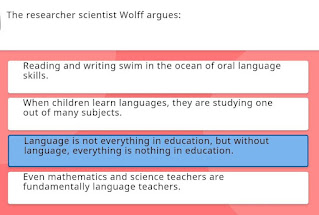FLN Module 7 Answer Key in English.
Multilingual Education In Primary Grades Quiz
Nishtha 3.0 FLN Module 7 - Multilingual Education In Primary Grades Answer Key in English
FLN 07 Answer Key in english
Question 2-
Which language is effective for the creation of knowledge?
Answer: Familiar
Language
Question 3-
According to the Census of India (2011), how many different mother tongues are
spoken in India?
Answer: 1369
Question 4: Which
of the following is true -
Answer: Proficiency
in various languages is developed in an interdependent fashion
Question 5-
Which one of the following is the best statement to summarize the learning of
this course:
Answer: In
areas where children's language cannot be used as medium of instruction right
away, it should be used strategically and extensively in the oral domain.
Question 6:
Which of the following strategies on L2 teaching are not effective in
foundational years?
Answer: Rote
learning of the varnamala and lessons from the textbook
Question 7- Which of the following statements does not feature in National Education Policy 2020?Answer: If children are taught through their mother tongues, they do not have adequate time in school to learn other languages.
Question 8:
National Education Policy, 2020 mentions in terms of multilingualism:
Answer: As
far as possible, the medium of instruction until grade 5 should be a language
that is familiar to children.
Question 9:
Which of the following is NOT an example of mixed language use?
Answer: The
teacher speaks in L2 and the children answer in L2.
Question 10:
Choose the incorrect sentence:
Answer: Children
struggle to learn other languages if they learn through mother tongue.
Question 11:
Choose a myth related to language teaching:
Answer: The
earlier children are given textbooks to read in an unfamiliar language, the
sooner they will learn that language.
Question 12:
Question: Choose the incorrect statement -
Answer: By
learning through the mother tongue, children find it difficult to understand
all the subjects.
Question 13: “Learning process must gradually move from
the familiar to the unfamiliar”. This idea can be found in-
Answer: NCF – 2005
Question 14: It shall be the endeavour of every state and of every local authority within the Stage to provide adequate facilities for instruction in the mother tongue at the primary stage of education to children belonging to linguistic minority groups” -which document is this statement recorded in?Answer: The Indian Constitution.
Question 15: What kind of language do we use in our
day-to-day life?
Answer: Mixed Language.
Question 16: Kamala lives in the Kota district of That and speaks Hadoti at home. She has joined grade 1 after a delay of 4 months; today is her first day at school. What will you do so that she feels comfortable in the classroom?
Answer:- I will informally chit-chat with her in Hadoti.
Question 17: Studies on the Ethiopian model of language
in education show that –
Answer: Children studying through their mother tongues
performed better in all academic subjects.
Question 18: Creative knowledge can
be constructed by traversing the bridge of -
Answer: Familiar Language.
Question 19: For the success of the Foundational Literacy and Numeracy (FLN) Mission, it is necessary to -
Answer: Making use of languages that are familiar to children.
Question 20: Why so about 25% of
children in elementary school face a severe learning disadvantage in
foundational years?
Answer: Language used in school and at home are different.
Question 21: Who does not face any
learning disadvantages due to language used in schools?
Answer: Children who study in English medium
schools have ample exposure to English at home.
Question 22: Language of
communication used by Adivasi communities working in the tea plantations of
Assam can be called as-
Answer: Link language.
Question 23: Which of the following is not a key feature of Multilingual Education?
Answer: Dominance of one language over others in the classroom.
Question 24: Who amongst the following children will struggle the most while learning?
Answer: Ramesh, which speaks Bhojpuri in his family and community and studies in an English medium school.
Question 25: Who has proposed the
“Common Underlying Proficiency” hypothesis of language learning?
Answer: Jim Cummins.
Question 26: Multilingualism
means-
Answer: Use of two or more languages by the person.
Question 27: Making use of L1 in
teaching-
Answer :- helps in better learning of all the subjects.
Question 28: According to UDISE, how
many languages are used as a medium of instruction in Indian schools ?
Answer :- 36
Question 29: Kamala ji wants to teach
Hindi to grade 2 students. Which of the following strategies should she use ?
Answer :- Use of Hindi language as per the level of comprehension
by students
Question 30: Which of the following is
not a benefit of Multilingual education ?
Answer :- Learning how to read and write in English from grade 1
Question 31: Which of the following
is true –
Answer :- Proficiency in various languages is developed in an
interdependent fashion
Question 32: Which of the following statements
regarding multilingual education is true ?
Answer :- Children’s languages are used as scaffolds for learning
new/unfamiliar languages.

